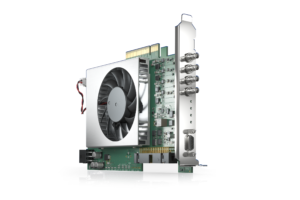Processors for Embedded Vision
THIS TECHNOLOGY CATEGORY INCLUDES ANY DEVICE THAT EXECUTES VISION ALGORITHMS OR VISION SYSTEM CONTROL SOFTWARE
This technology category includes any device that executes vision algorithms or vision system control software. The following diagram shows a typical computer vision pipeline; processors are often optimized for the compute-intensive portions of the software workload.

The following examples represent distinctly different types of processor architectures for embedded vision, and each has advantages and trade-offs that depend on the workload. For this reason, many devices combine multiple processor types into a heterogeneous computing environment, often integrated into a single semiconductor component. In addition, a processor can be accelerated by dedicated hardware that improves performance on computer vision algorithms.
General-purpose CPUs
While computer vision algorithms can run on most general-purpose CPUs, desktop processors may not meet the design constraints of some systems. However, x86 processors and system boards can leverage the PC infrastructure for low-cost hardware and broadly-supported software development tools. Several Alliance Member companies also offer devices that integrate a RISC CPU core. A general-purpose CPU is best suited for heuristics, complex decision-making, network access, user interface, storage management, and overall control. A general purpose CPU may be paired with a vision-specialized device for better performance on pixel-level processing.
Graphics Processing Units
High-performance GPUs deliver massive amounts of parallel computing potential, and graphics processors can be used to accelerate the portions of the computer vision pipeline that perform parallel processing on pixel data. While General Purpose GPUs (GPGPUs) have primarily been used for high-performance computing (HPC), even mobile graphics processors and integrated graphics cores are gaining GPGPU capability—meeting the power constraints for a wider range of vision applications. In designs that require 3D processing in addition to embedded vision, a GPU will already be part of the system and can be used to assist a general-purpose CPU with many computer vision algorithms. Many examples exist of x86-based embedded systems with discrete GPGPUs.
Digital Signal Processors
DSPs are very efficient for processing streaming data, since the bus and memory architecture are optimized to process high-speed data as it traverses the system. This architecture makes DSPs an excellent solution for processing image pixel data as it streams from a sensor source. Many DSPs for vision have been enhanced with coprocessors that are optimized for processing video inputs and accelerating computer vision algorithms. The specialized nature of DSPs makes these devices inefficient for processing general-purpose software workloads, so DSPs are usually paired with a RISC processor to create a heterogeneous computing environment that offers the best of both worlds.
Field Programmable Gate Arrays (FPGAs)
Instead of incurring the high cost and long lead-times for a custom ASIC to accelerate computer vision systems, designers can implement an FPGA to offer a reprogrammable solution for hardware acceleration. With millions of programmable gates, hundreds of I/O pins, and compute performance in the trillions of multiply-accumulates/sec (tera-MACs), high-end FPGAs offer the potential for highest performance in a vision system. Unlike a CPU, which has to time-slice or multi-thread tasks as they compete for compute resources, an FPGA has the advantage of being able to simultaneously accelerate multiple portions of a computer vision pipeline. Since the parallel nature of FPGAs offers so much advantage for accelerating computer vision, many of the algorithms are available as optimized libraries from semiconductor vendors. These computer vision libraries also include preconfigured interface blocks for connecting to other vision devices, such as IP cameras.
Vision-Specific Processors and Cores
Application-specific standard products (ASSPs) are specialized, highly integrated chips tailored for specific applications or application sets. ASSPs may incorporate a CPU, or use a separate CPU chip. By virtue of their specialization, ASSPs for vision processing typically deliver superior cost- and energy-efficiency compared with other types of processing solutions. Among other techniques, ASSPs deliver this efficiency through the use of specialized coprocessors and accelerators. And, because ASSPs are by definition focused on a specific application, they are usually provided with extensive associated software. This same specialization, however, means that an ASSP designed for vision is typically not suitable for other applications. ASSPs’ unique architectures can also make programming them more difficult than with other kinds of processors; some ASSPs are not user-programmable.

Free Webinar Explores Developments and Prospects in Neuromorphic Sensing and Computing
On July 11, 2024 at 9 am PT (noon ET), Adrien Sanchez and Florian Domengie, senior technology and market analysts at the Yole Group, will present the free hour webinar “The Rise of Neuromorphic Sensing and Computing: Technology Innovations, Ecosystem Evolutions and Market Trends,” organized by the Edge AI and Vision Alliance. Here’s the description,

AiM Future Brings GenAI Applications to Mainstream Consumer Devices
Seoul, Korea, and San Jose, CA – May 15, 2024 – AiM Future, a leading provider of concurrent multimodal inference accelerators for edge and endpoint devices, has just announced the launch of its next-generation Generative AI Architecture, “GAIA,” and Synabro software development kit. These GAIA-based accelerators are designed to enable energy-efficient transformers and large language

AI Decoded: New DaVinci Resolve Tools Bring RTX-accelerated Renaissance to Editors
This blog post was originally published at NVIDIA’s website. It is reprinted here with the permission of NVIDIA. Latest update adds two AI-assisted tools that perform best on NVIDIA GPUs. AI tools accelerated by NVIDIA RTX have made it easier than ever to edit and work with video. Case in point: Blackmagic Design’s DaVinci Resolve

Introducing TENN: Revolutionizing Computing with an Energy Efficient Transformer Replacement
This blog post was originally published at BrainChip’s website. It is reprinted here with the permission of BrainChip. TENN, or Temporal Event-based Neural Network, is redefining the landscape of artificial intelligence by offering a highly efficient alternative to traditional transformer models. Developed by BrainChip, this technology aims to address the substantial energy and computational demands

The SHD Group, in Collaboration with the Edge AI and Vision Alliance™, to Release a Complimentary Edge AI Processor and Ecosystem Report
SAN JOSE, Calif. – May 14, 2024 – The SHD Group, a leading strategic marketing, research, and business development firm, today announced the creation of an edge AI report that will be a resource for both product developers and ecosystem providers. This guide will detail processors integrating AI accelerators, standalone acceleration chips, accelerator IP, software,

BrainChip and Frontgrade Gaisler to Augment Space-Grade Microprocessors with AI Capabilities
Laguna Hills, Calif and Göteborg, Sweden – May 6, 2024 – BrainChip Holdings Ltd (ASX: BRN, OTCQX: BRCHF, ADR: BCHPY), the world’s first commercial producer of ultra-low power, fully digital, event-based, neuromorphic AI IP, and Frontgrade Gaisler, a leading provider of space-grade system-on-chip solutions, announce their collaboration to explore the integration of BrainChip’s Akida™ neuromorphic

Avnet to Exhibit at the 2024 Embedded Vision Summit
05/09/2024 – PHOENIX – Avnet’s exhibit plans for the 2024 Embedded Vision Summit include new development kits supporting AI applications. The summit is the premier event for practical, deployable computer vision and edge AI, for product creators who want to bring visual intelligence to products. This year’s Summit will be May 21-23, in Santa Clara, California. This

Korean Semiconductor Industry Titans Back DEEPX in Series C Funding Round
SEOUL, South Korea, May 10, 2024 /PRNewswire/ — DEEPX, a prominent AI semiconductor technology startup under the leadership of CEO Lokwon Kim, is delighted to announce the successful conclusion of its Series C funding round, amassing $80.5M (KRW 110B). Led by esteemed private equity firms, this significant financial investment will accelerate the mass production of

Beyond Smart: The Rise of Generative AI Smartphones
This blog post was originally published at Qualcomm’s website. It is reprinted here with the permission of Qualcomm. From live translations to personalized content management — the new era of mobile intelligence It’s 2024, and generative artificial intelligence (AI) is finally in people’s hands. Literally. This year’s early slate of flagship smartphone releases is a

Lattice to Showcase Advanced Edge AI Solutions at Embedded Vision Summit 2024
May 08, 2024 04:00 PM Eastern Daylight Time–HILLSBORO, Ore.–(BUSINESS WIRE)–Lattice Semiconductor (NASDAQ: LSCC), the low power programmable leader, today announced that it will showcase its latest FPGA technology at Embedded Vision Summit 2024. The Lattice booth will feature industry-leading low power, small form factor FPGAs and application-specific solutions enabling advanced embedded vision, artificial intelligence, and

BrainChip Adds Penn State to Roster of University AI Accelerators
Laguna Hills, Calif. – May 8, 2024 – BrainChip Holdings Ltd (ASX: BRN, OTCQX: BRCHF, ADR: BCHPY), the world’s first commercial producer of ultra-low power, fully digital, event-based, neuromorphic AI IP, today announced that Pennsylvania State University has joined the BrainChip University AI Accelerator Program, ensuring students have the tools and resources necessary to help

Basler Presents a New, Programmable CXP-12 Frame Grabber
With the imaFlex CXP-12 Quad, Basler AG is expanding its CXP-12 vision portfolio with a powerful, individually programmable frame grabber. Using the graphical FPGA development environment VisualApplets, application-specific image pre-processing and processing for high-end applications can be implemented on the frame grabber. Basler’s boost cameras, trigger boards, and cables combined with the card form a

BrainChip Earns Australian Patent for Improved Spiking Neural Network
Laguna Hills, Calif. – May 6, 2024 – BrainChip Holdings Ltd (ASX: BRN, OTCQX: BRCHF, ADR: BCHPY), the world’s first commercial producer of ultra-low power, fully digital, event-based, neuromorphic AI, received its latest Australian patent, further strengthening its IP portfolio related to sustainable and efficient AI technologies. Patent AU2022287647, “An Improved Spiking Neural Network,” facilitates

Gigantor Technologies Welcomes Major General Viet Luong as Executive Vice President
March 6, 2024 — Gigantor Technologies INC, a leading innovator of high-performance Edge AI systems, proudly announces the appointment of Major General (Retired) Viet Luong as the Executive Vice President. With an illustrious career spanning over three decades in the United States Army, Major General Luong brings invaluable strategic leadership and operational experience to Gigantor

Defense Business Accelerator (DBX) Challenge
Gigantor Technologies Wins $2M Contract at Defense TechConnect Innovation Summit & Expo February 13, 2024 — Gigantor Technologies, a trailblazer in cutting-edge AI solutions, emerged triumphant at the Defense TechConnect Innovation Summit & Expo in Maryland. Chief Marketing Officer Jessica Jones showcased Gigantor’s pioneering technology at the Defense Business Accelerator (DBX) Microelectronics Challenge, securing a

Revolutionizing AI Computation: Custom Mass Multiplication Circuits
US Patent Number 11,748,061 Granted on September 5, 2023 September 7, 2023 — Gigantor Technologies Inc — In a groundbreaking leap forward for artificial intelligence and computational efficiency, the United States Patent and Trademark Office (USPTO) has officially approved Patent Number 11,748,061, detailing the innovative Custom Mass Multiplication Circuits. This invention marks a monumental shift

LLMs, MoE and NLP Take Center Stage: Key Insights From Qualcomm’s AI Summit 2023 On the Future of AI
This blog post was originally published at Qualcomm’s website. It is reprinted here with the permission of Qualcomm. Experts at Microsoft, Duke and Stanford weigh in on the advancements and challenges of AI Qualcomm’s annual internal artificial intelligence (AI) Summit brought together industry experts and Qualcomm employees from over the world to San Diego in

More than 500 AI Models Run Optimized on Intel Core Ultra Processors
Intel builds the PC industry’s most robust AI PC toolchain and presents an AI software foundation that developers can trust. What’s New: Today, Intel announced it surpassed 500 AI models running optimized on new Intel® Core™ Ultra processors – the industry’s premier AI PC processor available in the market today, featuring new AI experiences, immersive graphics

S32N Family of Scalable Processors Super-integrates Vehicle Functions for Tomorrow’s SDVs
This blog post was originally published at NXP Semiconductors’ website. It is reprinted here with the permission of NXP Semiconductors. To support the transition to future vehicles where capabilities and features are defined with software code, rather than with hardware boxes, a new approach to design them is required. NXP has announced the new S32N

Mixed Messages on MaaS Market Readiness: An Analysis of New Driverless Vehicle Testing Data From the California DMV
Over the last three to four years, the driverless robotaxi industry has begun to flourish. Driverless services are coming online in multiple cities across the US and China. IDTechEx‘s recent report, “Future Automotive Technologies 2024-2034: Applications, Megatrends, Forecasts“, predicts that the driverless robotaxi industry will be generating over US$470 billion annually through services in 2034.

